Journeys in STEM
Transitioning through academic levels to a career is a journey. The AccessSTEM and AccessComputing projects, both led by the University of Washington (UW) and funded by the National Science Foundation (NSF), help students with disabilities toward careers in science, technology, engineering, and mathematics (STEM), with AccessComputing more narrowly focused on computing fields. DO-IT—which stands for Disabilities, Opportunities, Internetworking, and Technology— partners with the UW College of Engineering and Department of Computer Science and Engineering to undertake these projects that promote the success of individuals with disabilities in college, graduate school, and careers.
In AccessSTEM and AccessComputing hundreds of individuals with disabilities have participated in activities that increase STEM interest and success through critical junctures (e.g., high school graduation, enrollment in college) and transitions (e.g., military service to college, 2-year to 4-year school, undergraduate to graduate school, college to career). Participants engage in activities that include STEM internships, mentoring, self advocacy practice, peer support, role-play interactions with faculty and employers, and career opportunities.
The AccessSTEM critical junctures model (see Figure below) identifies key steps that lead to the success of students with disabilities in STEM careers. Based on a literature review and over twenty years of practice in the field, the model also highlights interventions (e.g., mentoring, research experiences, technology access) that support students on their journeys.
The AccessSTEM/AccessComputing/DO-IT Longitudinal Transition Study (ALTS) measures success in taking critical steps toward STEM careers of participants with disabilities in activities sponsored by AccessSTEM and other projects sponsored or co-sponsored by the DO-IT Center at the UW. To date, more than 300 students with a wide range of disabilities participate in this ongoing study.
In ALTS, participants are asked to report key academic and work-based achievements. They also identify the DO-IT activities they participated in and rate the value of specific activities. Researchers record the “on track” status of respondents as they progress through critical junctures that lead to degrees and careers in STEM. As this database grows, it increasingly reveals the long-term impact of DO-IT’s program activities. It quantifies the relative importance of activities for achieving positive postsecondary outcomes. More information about ALTS and its current results are available at www.uw.edu/doit/2011-report-accessstemaccesscomputingdo-it-longitudinal-transition-study-alts.
Ultimately, understanding the STEM journeys of students with disabilities requires that we hear their stories, understand their struggles, and reflect on their experiences. The following section of this book shares essays about journeys in STEM from participants in AccessSTEM, AccessComputing, and other DO-IT programs.
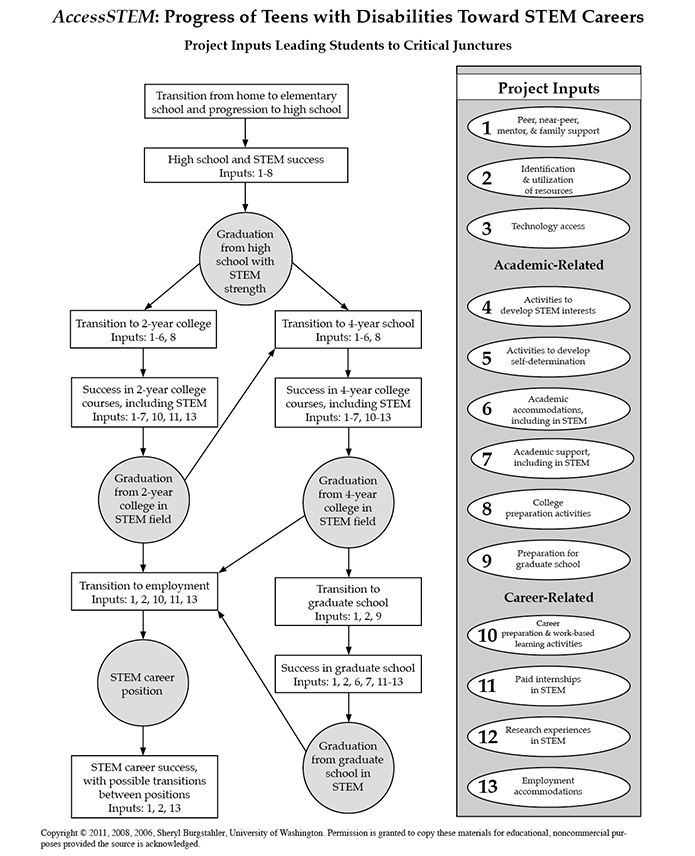
Vincent
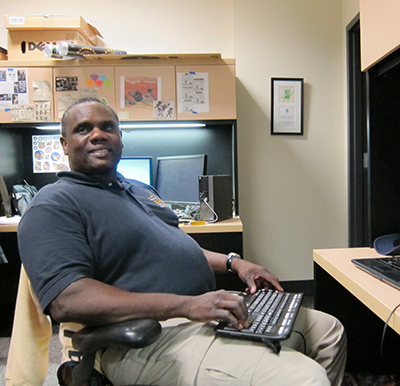
My mother told me that the encyclopedias that still sit on the shelves in their house in my hometown were purchased because of my constant questions about how everything worked.
Even playing sports, I always took the analytical route towards getting something accomplished, instead of just trying to play for fun. I’m sure that’s what started my journey into a STEM-related major and career. I truly believe this is how I came to study several different STEM fields, as none of them led me to answers. Rather, more intriguing and complex questions have unfolded along the way.
I am currently a PhD student in human centered computing, which is best defined as the intersection between humans and computers. I got to this point in my education and career by way of two different engineering undergraduate degrees, a third undergraduate degree in psychology with an emphasis in engineering psychology, and a master’s degree in human computer interaction. My various degrees are all relevant in the research being done with mobile and ubiquitous computing. I’ve also learned, unexpectedly, that my STEM education has been more useful in my day-to-day life than it has in my work career.
I diagnosed my own eye disease as a result of diligence on my part and not accepting the answer of, “there is nothing wrong with your eyes that we can see.” Most importantly, after a diagnosis of retinitis pigmentosa was confirmed, I used my technical background to start creating modifications that would make me an efficient and productive worker. My engineering background, which relied heavily on mathematics, science, and reasoning power, led me to design my own assistive technology devices and better understand those that already existed. Because of these interests, I ventured into rehabilitation engineering. After many years of work and being recruited to work as a rehabilitation research engineer at a lab, I realized that I wanted to do research for the rest of my life.
In order to achieve that goal, I had to return to school to garner the degrees and knowledge to become a principal investigator. I added a degree in psychology to enhance my understanding of human behavior and realized that the majority of my work had been in dealing directly with computers and humans. That is how my final phase of education came to focus on human computer Interaction and will culminate with a PhD in human centered computing. The next step in my STEM journey is completing my PhD and diving into the research with unbridled enthusiasm.
Katie
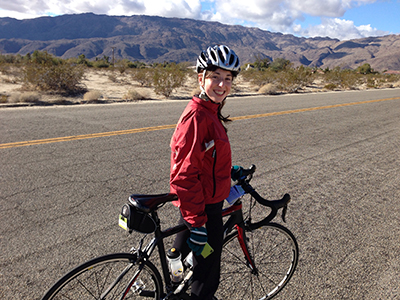
Engineering
My journey into STEM can be traced back to a quick web search in high school. I loved math and was on the hunt for a college major that would allow me to study math for as long as I could. That’s how I first learned about engineering.
I selected Olin College of Engineering for its small size and innovative hands-on engineering program, and I decided to concentrate in computing based on my experience with Java programming. As a deaf student, Olin was perfect for me—its small and intimate classes made it easy for me to lip read, and I never felt uncomfortable asking professors or classmates to repeat themselves.
At Olin, I learned how to design products and services that meet real user needs. I put those skills to use during my internship at the University of Washington (UW), where I worked on a project called “ClassInFocus.” ClassInFocus brings all of the information that might be presented in a mainstream classroom (captions, videos, slides, and notes) onto one screen, making it more accessible to deaf students. I loved my first real taste of how rewarding it was to work on assistive technology!
During that same summer, I had the opportunity to visit companies like Microsoft, Google, and Adobe with students in an AccessComputing program called the Summer Academy for Advancing Deaf and Hard of Hearing in Computing. We learned what it was like to work in the tech industry, and we met several Deaf professionals in the field.
In my senior year at Olin, I applied for a program manager position at Microsoft. It felt like a perfect fit for the design and management skills I had acquired. I got the position, and I’m currently on the Microsoft Word team. It’s still hard for me to believe I’m designing features for such a popular product. It’s hard to say where my STEM journey will take me next.
Microsoft has excellent accommodations for deaf employees. Interpreters and captioning are available for all meetings and events. While I still face challenges, I have great co-workers who understand my needs. They’re happy to repeat things when I ask and even remind each other to face me while they’re talking.
Since starting at Microsoft, I’ve returned to visit the Summer Academy at the UW, and I have spoken on various panels about my experiences. The advice I give is to always advocate for yourself, to be persistent, and to use the resources available to you, whether it’s reaching out to people or requesting accommodations. It’s fun and rewarding to share my experiences with others and hear their stories and advice as well.
Joseph
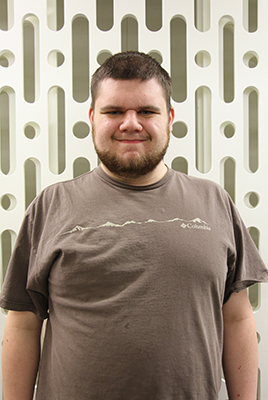
Engineering Technology
I’ve always loved tinkering around with technology. My high school had a friendly, small, and inclusive student body. I volunteered in the district’s “Bridging The Gap” program, where I tested surplus computers and taught people how to set them up. I liked this volunteer position because it gave me a taste of what a work ethic feels like, and gave me confidence that I could use my skills in a more formal setting.
I earned the “Technology Superstar” award for working as an extra tech hand for my school. That was a great experience because it allowed me to work on the copiers, projectors, and computers that I previously only dreamed of messing with. I also enrolled in Running Start, which greatly eased the transition to college. The experience was a nice middle between high school and college; I still had a familiar environment and available help from home, but the courses were full-blown college-level courses on a schedule that worked very well for me.
The event that really motivated me to pursue a STEM degree was getting into a college-preparation program for students with disabilities called DO-IT Scholars. I got to live on a university campus, learn valuable studying skills, and create a community of people who understood me. During my second summer on campus, I really appreciated the engaging laboratories, career-focused workshops, and networking events—all of which helped me get into Central Washington University.
At first, pursuing an electronics engineering technology degree at a four-year university felt like one obstacle after another. Fortunately, after learning how to use disability services and jumping over some of the early hurdles, things began improving.
During college, I participated in a National Science Foundation-funded program called AccessSTEM that helped me secure an internship. At the internship, I developed a microcontroller-based device that allowed single-switch and two-switch assistive devices to use a code to emulate a keyboard. I aimed to make something both affordable and versatile for people who can’t use a keyboard. I felt like my project could make a difference for someone in the world. The experience gave me the confidence that college had prepared me well for a computer engineering career.
My journey has been difficult, and I have experienced many barriers. Often other’s lack of awareness of my disability has caused barriers in my career pursuits, but I still look forward to finding a place that’s a good fit for me and settling into a career.
Alexandra
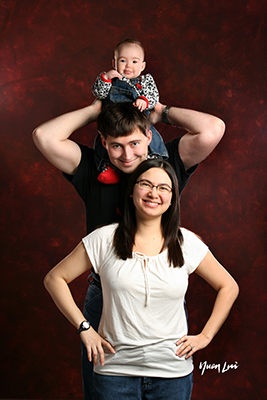
Microbiology
I‘ve always been interested in how biological systems function. When I was thirteen, Stargardt’s Disease reduced my visual acuity from 20/20 (perfect vision) to 20/200, the threshold for legal blindness. Suddenly I was a student with a visual impairment.
One of the accommodations offered to me was waiving core math and science classes. I was stunned. I declined that offer. I soon learned that there were very few visually impaired students in my high school and even fewer who had pursued math and science. That got me fired up, and I think that’s where my journey in STEM first started.
I worked closely with my teachers to make classes and labs accessible. I enrolled in a college-preparation program DO-IT Scholars, which turned out to be an incredibly useful resource. I received encouragement to pursue college and a career in science, learned about self-advocacy, and received advice from staff, mentors, and other participants.
My tenth grade biology teacher was particularly inspiring. To enhance our labs, she joined a program to borrow equipment from a well-known, local cancer research center. I was really excited to visualize DNA on a gel, but I had great difficulty navigating the clear pipette tip into the tiny gel wells. We spent several hours practicing by gently probing the edges of the wells instead of locating them visually, a technique I would utilize daily as a research scientist.
During college at the University of Washington, I refined my scientific interests through a combination of course work and undergraduate research. My first taste of real bench science was during sophomore year in the department of microbiology. I characterized denitrifying microbial life present in an environmental sample from the Black Sea. I learned to listen for thaw in frozen liquid reagents instead of looking for ice chunks. During Ethanol precipitations to isolate DNA, we discovered that though I couldn’t see the tiny DNA pellet, I could identify the slight orange refraction of the pellet when the tube was rotated under a strong light source. Experiences like these gave me confidence that I could make bench work accessible.
I next joined a lab in the department of biochemistry focusing on gene expression. I spent two years investigating an intronic regulatory region in Muscle Creatine Kinase, a gene commonly used to model muscle gene expression. I assembled a large arsenal of widely applicable molecular biology bench skills and became proficient in experimental design, good record keeping, and, through a variety of presentations, science communication to multiple audiences. However, I also encountered some serious limitations due to my vision. After much deliberation, I decided that I needed to take a more genomic approach to gene expression research to optimize for model systems with which I could more easily work.
Following graduation from college, I joined a lab in the Department of Genome Sciences at the University of Washington as a research scientist, where I developed innovative procedures and technologies to sequence genomes more efficiently and informatively.
Andrea
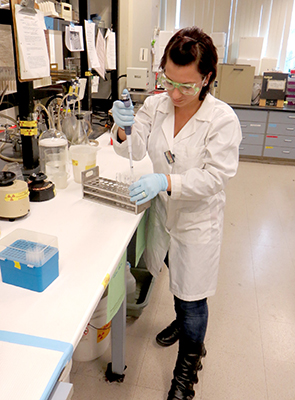
Disease Research
I was always interested in science, ever since I was a child. My parents encouraged this and bought me a junior microscope set, made mostly of blue and red plastic. I would spend hours shoving bugs and any other willing (or unwilling) creatures under it. I was constantly searching for and exploring scientific answers to the natural world.
For nearly ten years of my adult life, it felt like Chronic Lyme’s Disease (CLD) tried to defeat me, but ultimately I won out. I was undiagnosed for eight of those ten years, despite the fact that I saw a great many doctors. This inspired me to pursue my dreams of becoming a really solid research scientist, despite the fact that on a daily basis I was dealing with a multitude of symptoms.
Feeling sick became a part of everyday life for me, but I didn’t let that stop me. Because I was undiagnosed for so long and untreated, my grades suffered but I never gave up, not even after getting disqualified from a major university or being told that I should settle on a more menial career path. I made sure that nothing could stop my momentum and vivacity—not my cane or wheelchair and not the migraines, insomnia, or Bell’s Palsy. My journey was underway and I was determined to stay on the path.
Despite the fact that I have recovered from CLD, it has left a handful of challenges that I must overcome on a daily basis. I have nerve damage and suffer from tremors and other neurological issues. This has made academic pursuits challenging, but after 13 years of pursuing my degree, I’m reaching my destination as I prepare to enter the workforce as a research chemist with a background in molecular biology and biotechnology.
While I have been forced to work through many daily encumbrances, I manage to keep a positive attitude, which seems endless at times, thankfully. It is because of this and my inspirational mentors, including the doctors who first diagnosed my CLD and ultimately cured me, that I was able to realize my dreams and fulfill my ambitions. I look forward to helping and inspiring others throughout my career in disease research. I know I offer a unique perspective to this field, with my first-hand experience with such a tenacious disease. Although I still have to be on routine medication and therapy, I am grateful and feel privileged and proud to be a scientist.
Joe
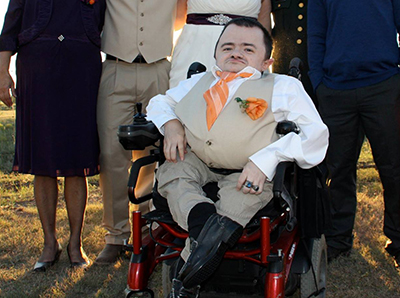
Education
I was born with brittle bones. By my teens, I had dozens of breaks, but they slowed as I went through high school. I had parents who fought to ensure I led as normal of a life as possible. For example, I lived in dorms as an undergraduate student in a university near my hometown. I was then accepted to Teachers College, Columbia University for my master’s degree. I moved to New York City, finished my master’s degree, and then moved to Seattle to get my doctoral degree in education at the University of Washington.
I have been very interested in research methods, especially statistics. Using advanced methods to analyze policy data is my career goal. In 2014, I graduated from the University of Washington with a PhD in education: measurements, statistics, and research design; my thesis was titled “Retention of Undergraduate Students with Disabilities at the UW: Advancing Retention Knowledge and Policy Implications.”
My journey in STEM has required overcoming physical and psychological barriers. While I am at times around people with disabilities, my social circles primarily include people without disabilities. Fitting in seems to be harder with each passing year. I could rationalize this when I was younger, hoping a greater education and professional success would translate into social acceptance, yet this was always somewhat of an illusion. I do have a close group of friends and family that provide emotional support, but this doesn’t take away my sense of exclusion.
All of my life I’ve used my intellect to solve problems, yet with each passing year the limits of intellect to find a sense of satisfaction in life continue to be evident. After spending well over a decade in higher education as a way of coping with life, I’m now focusing on dealing with emotions I have long suppressed.
Ultimately, I realize that life can be one struggle after another for a lot of people, not just those with disabilities. My personality will not let me accept just treading water in life. I always want to achieve more and push myself harder. Quitting the fight has never been an option. That’s why I believe that while my journey has been long, it has really only just begun.
Todd
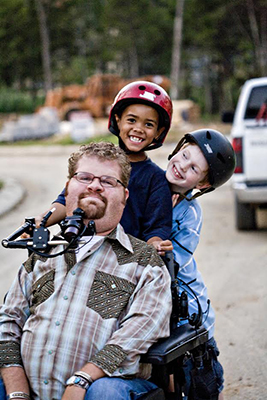
Technology & Independence
My life has never been easy, but I am grateful every day for the opportunities I have received and experiences I have had. I have C4 complete quadriplegia, but that hasn’t stopped me from pursuing a great career in science and technology, marrying a great woman, and continuing to serve my community in every way I can.
I earned my associate’s degree in computer programming from RCH Technical Institute concurrently with my high school diploma, and I went to work for a software company specializing in medical products immediately following. I opened my own consulting company called C4 Consulting, where I serve the electronic personal health information space. My company is responsible for protecting patient data in hospitals and laboratories across the United States.
I have also been a motivational speaker for years, telling my story and encouraging others to follow their dreams. I also opened a foundation in 2008 to provide independent technologies to people with spinal cord injuries. We just recently launched a new program called “Demonstrating Independence,” which will provide more technologies to people for managing life tasks on their own.
I have always been interested in how science can give independence to people who may otherwise have fewer options for engaging in our society. Technology is a growing industry that is constantly coming up with newer and better methods for people with disabilities to be independent in whatever career they choose. My journey in STEM is intricately tied to this changing technological landscape.
I owe a lot to mentors and other supportive people for giving me great experiences and helping me with career skills, which led to a job in the technology field. I value relationships and staying close with those you care for. I will always be a man with purpose, fighting for the important things in my life. I look forward to many more years with my family and giving back to society.
Jae
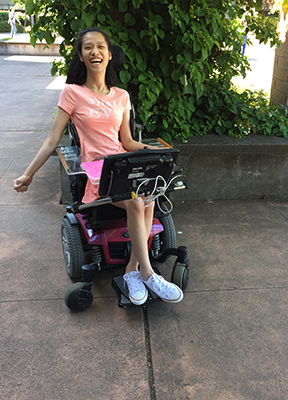
Transition Specialization
During my journey as a student and a lover of science, there have been tears as well as smiles. Although it has been rewarding, it hasn’t been easy. My life really changed in ninth grade, when I started going to general education classes. Up until that point, I had been participating in a Learning Resources Center that focused mostly on social skills and skills of daily living.
When I shifted to a different Learning Resources Center at my high school, I was enrolled in more mainstream classes. This was great. I had always wanted to be a regular student who attended mainstream classes every day—struggling with real academic work and challenging homework just like everyone else. Looking back, I wish I could have made the change earlier, because I wasn’t fully prepared for it. I didn’t have a lot of experience doing homework and assignments. It was hard for me to sit at a desk and listen to teachers talking for an hour. I just wasn’t used to that kind of learning.
In the evening, I often cried because I was flummoxed about everything going on in my classes.
I asked a principal to transfer me to another school with a specialized education system. She said “no” and kept pushing me to learn how to be successful. It wasn’t easy, but I started to get used to my new life. I got an excellent communication device called ECO, which gave me a voice to express my feelings and the chance to move forward with my life. It expanded my world beyond my imagination.
It was still hard for me to catch up with my classmates and it took me extra time to do things. Luckily, with my friends’ help, I caught up. During those years, I also discovered my dream: to be a transition specialist who helps disabled students be successful in high school, prepare for college, and overcome challenges. To do this, I need to understand the different kinds of assistive and mainstream technology, which builds on my interest in STEM.
Many people have helped me be successful in my journey so far—my transition specialist, friends, school staff, and family. At first, I wasn’t sure if I would be able to go to college and pursue my dream, but I was encouraged to face the challenges, especially from my transition specialist. She believed in me more than anyone. I am thankful to have her in my life.
I think that all human beings are on a journey of some sort. I hope I will impact other peoples’ lives in the same way that my transition specialist impacted mine.
Jessie
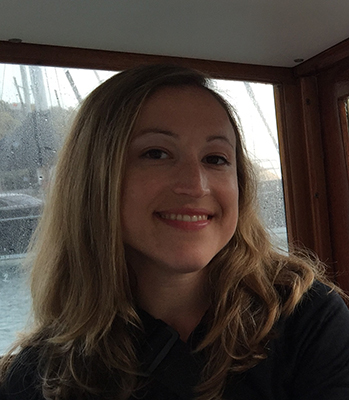
Information Technology
Growing up, I spent a lot of energy trying to disguise my disability and blend in with my peers. I have always been fascinated by the way things work and gravitated to math and science courses where my learning disability was less of an obstacle.
I got more focused on my journey in STEM when I participated in the DO-IT Scholars program, a transition- to-college program for students with disabilities during high school. This experience was liberating! I finally had a peer group where I could talk openly about my disability, the struggles I have had, and strategies for success. During the program, I learned to advocate for myself, gained confidence about the prospect of going to college, and made lifelong friendships.
I come from a long line of engineers, so when I entered college, I knew I wanted to go into the sciences and found my calling in the information sciences. College was an opportunity for me to combine my diverse interests, a place where I could work on an Informatics degree and a minor in Dance. A great day included engaging in a morning ballet class, going to class and then spending the evening in the computer lab working on database projects.
One summer in high school, I spent a week working on a project in a virtual reality lab. What a great experience to be exposed to cutting edge research! I was able to continue working at the lab as a summer intern, and then later as part of an independent study course.
During college I participated in numerous internships, one taking me as far away as the World Bank in Washington DC. While I had to work really hard to keep up in college, these experiences helped me realize the differences between a classroom setting and a job. I gained confidence in my skill sets and the contributions I could make in the workplace.
My STEM journey really got going with my first job after college. I was working in a technology leadership rotation program at Washington Mutual Bank. Over the course of a year and a half, I worked in the core retail banking systems, commercial banking technologies and the enterprise data warehouse.
Today I work on the Amazon Web Services Cloud Commerce platform where I focus on payments and international expansion. At work, I use text-to-speech software to review my writing and assist in reading documents quickly. What I enjoy most about my job is tackling tough technical and customer experience problems with a cross-functional team.
Daniel
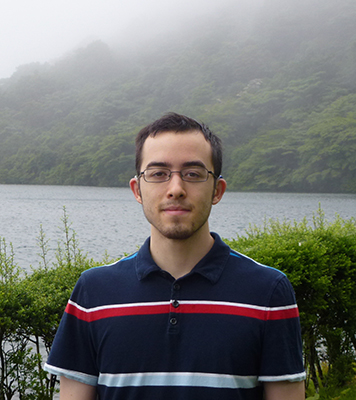
Research & Computing
I was born deaf, but fortunately received education in a public school district that had a program to accommodate deaf students. In my classes I had sign language interpreters and note-taking services. These accommodations played a major part in my academic success in high school, helping me graduate with highest honors. After high school, I enrolled at Williams College, a small liberal arts college in rural Massachusetts.
I have used summer time well during my journey in STEM. During high school, I attended the AccessComputing Summer Academy for Advancing Deaf and Hard of Hearing in Computing at the University of Washington. This was a fully-funded, nine-week residential program for deaf and hard of hearing students chosen from a nationwide pool. While at the Summer Academy, I was able to visit companies like Google and Microsoft and attend research presentations given by computer science graduate students.
I was intrigued by the research presentations and wanted to get involved in my own research projects. I realized that summer was a great time to engage in research. I’ve participated in two Research Experience for Undergraduates (REU) programs. These programs, funded by the National Science Foundation, hire students each summer to work on a research project at a college or university. One summer, I worked at the Bard College REU on an applied machine learning project.
The following summer, I was at the University of North Carolina at Greensboro’s REU, performing combinatorics research. These REUs were my first experiences in a real job situation, so I set up accommodations for myself. At Bard College, they hired sign language interpreters who came to campus when students or faculty gave research presentations. Unfortunately, interpreting a technical talk is a very difficult task because of the technical jargon and the need for specificity. So, while I was at Greensboro, I decided to rely entirely on a frequency modulation (FM) system, which amplifies the instructor into a speaker just for me to hear.
My post-college plan is to pursue a Ph.D. in computer science. Recently, I sent out applications to ten computer science Ph.D. programs and a variety of fellowships and scholarships. I’m not sure where my STEM journey will take me, but my hope is that graduate school will prepare me for my ideal career as a professor or a research scientist.
Frank
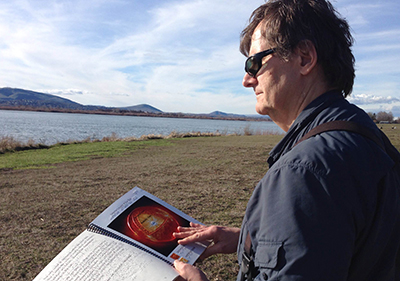
Engineering
My journey in STEM began in grade school in the form of a gift. My grandfather gave me an old book on radio theory. I loved it. Even though I was blinded a few years later, it never occurred to me to try a different path than electronics! After high school, I attended Montana State University, where I majored in electrical engineering and was awarded the nation’s largest scholarship for students seeking degrees in STEM fields.
I pretended that I could still see in those days. I never stopped being proud, but eventually I did start using a long white mobility cane. My mentor Fred, who hired me as an electronics technician in the Physics Department, taught me how to solder and debug circuits. Together we designed and built all kinds of great tortures for the instructors to inflict on their students in the physics labs. I still had a small amount of vision in those days, and I used an old blackboard, white chalk, and a magnifying glass to solve many of my math problems.
I worked for Battelle Pacific Northwest Laboratory for many years as an electronics technician, a senior computer consultant, and an electrical engineer. During these years I also earned my masters degree in electrical engineering from Washington State and became a registered professional engineer.
One of the fun things we did in our spare time at Battelle was to build a robot called the Cubot that could not only solve the Rubik’s cube puzzle mathematically, but could also physically solve the puzzle, turning the faces of the cube with its manipulators. I programmed the robot’s speech using 80186 assembly language.
In the late eighties I decided I wanted to attend Space Camp—the ultimate playground for lovers of the space program. Today, the camp has a great program for students who are blind, but, when I applied, they would not even consider such an incursion. It took the support of two senators and the assistance of the white cane law for me to finally become the first blind person to attend Space Camp.
When Galileo studied gravity, he didn’t just drop two balls of different weights from the Leaning Tower of Pisa; he rolled them down an inclined plane, which allowed for easier examination. It amazes me how unique approaches from intelligent people can solve life’s mysteries. This is why I have devoted my life to the field of science and engineering. It’s been a great journey so far!
Svetlana
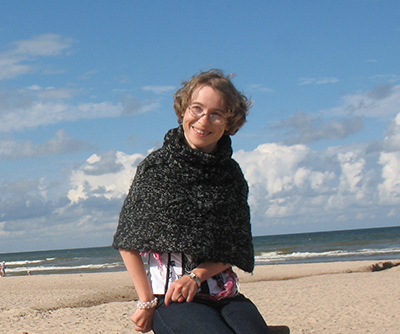
Research
My lifelong journey in STEM got off to a challenging start. I was born with a severe form of cerebral palsy that affects most of my body. Throughout my life, I have had to overcome many obstacles, physical as well as social.
In 2002, I came to the US from Latvia, a small country in Europe where doctors gave me a prognosis that I would never walk. Some of my middle and high school teachers refused to teach me, reasoning that there would be no way for me to utilize anything I learned. At the time there were few, if any, accessible buildings and social stigma towards those with disabilities was high. However, time changes and today I can walk—though I do use a wheelchair at times. I’m pursuing a Ph.D., and I excel in my academic pursuits.
I have always had a passion for knowledge. I eventually enrolled at Washington State University (WSU) to pursue a computer science degree because it has such a large variety of applications. During my junior year I participated in research for the first time through a Research Experience for Undergraduates (REU) program. I continued to build my research skills during the next couple of years as I participated in the Undergraduate Biology and Mathematics (UBM) program. My REU work resulted in a refereed conference paper, and my UBM work was showcased at the annual conference at the National Institute for Mathematical and Biological Synthesis. I also regularly participated in poster presentations and symposia at WSU and was the lead author on two refereed journal publications and a coauthor on a third paper.
I graduated with a bachelor’s degree and stayed at WSU to pursue a Ph.D. in computer science. My Ph.D. research is centered on machine learning methods in high dimensional spaces. I apply it to bioinformatics, neuroscience, imaging, speech recognition and many other fields.
I’ve put a lot of time and energy into my studies and that has really paid me back. My achievements have been recognized at the national level several times. I was awarded the prestigious Barry M. Goldwater Scholar Award, I was chosen as a finalist Computing Research Association’s Outstanding Undergraduate Research Award Competition, I received a Graduate Research Fellowship from the National Science Foundation, and I was awarded a grant to go to Norway to conduct a research in one of the most prestigious centers for neuroscience.
My goal is to become a scientist and benefit society through my research, teaching, and scientific work.
Erica
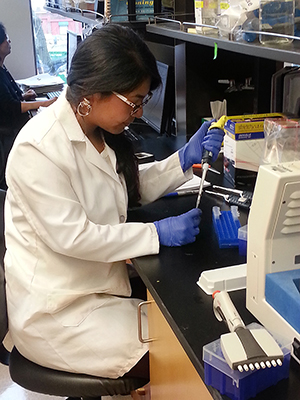
Public Health
I grew up in a rural area of Washington State. I am Mexican-American and have Erb’s palsy, which limits the mobility of my right arm. Coming from a rural, underserved area has made me passionate to improve healthcare accessibility. My interest in STEM fields is connected with my background and the communities I would like to serve as a physician.
Many Latino families in central Washington communities work in agricultural jobs. Despite being one of the toughest jobs, most migrant workers have no choice but to continue working in such conditions to support their families. Most farmworkers do not have health insurance or access to healthcare. Pursuing biology and public health majors was perfect for what I see myself doing in the future. My goal is to provide equal opportunities for all people seeking healthcare and to improve healthcare in underserved communities.
My STEM journey has taken me to many great places. In the summer of 2011, I attended the ten-week Initiative for Maximizing Student Diversity Teach Lab program. Later that summer, I studied abroad, analyzing the public and private healthcare systems implemented in India. The next summer I participated in the six- week Summer Medical Dental Education Program at Columbia University in New York City. Later that summer, I participated in a public health exploration seminar in Chile. The following year, I did an internship with Seattle Biomedical Research Institute in the Protein Production Core as an undergraduate research assistant. During the summer of 2013, I completed a ten-week internship at the University of Washington (UW) Bioengineering Department as an undergraduate research assistant and then went to a healthcare seminar in Italy.
Being part of the AccessSTEM program allowed me to network and build connections with people at the UW. I have also reached out to other programs on campus that support underrepresented minorities going into STEM fields. I am also part of Lambda Theta Alpha, Latin Sorority, Inc., where I serve as Chapter President. Taking on this leadership role constantly pushes me out of my comfort zone and allows me to grow as a person and a leader.
As a young Latina, growing up in rural Pateros, WA, I never thought I would do half of the things that I have done already. There have definitely been times when I remind myself to not only accept myself with my disability, but to love myself and the stronger person I have become because of it. When I look back at who I was when I entered the UW, all of these programs and experiences has made me a more confident, accomplished, and educated woman.
Chris
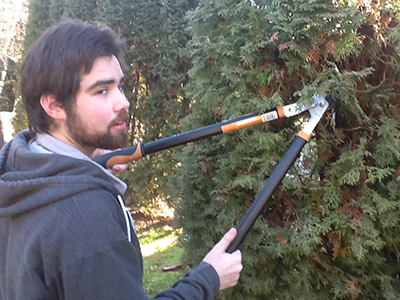
Natural Systems
I am a student at Clark College in Vancouver, WA, pursuing a bachelor of science degree in forestry. I have always loved learning. Gaining knowledge about the inner cogs of the universe is enticing.
While growing up, my favorite TV shows were on the Discovery Channel, History Channel, and Animal Planet. I now learn through the Internet, science news, TED videos, various podcasts, YouTube channels, and online college lectures.
My attention deficit disorder (ADD) and dyslexia make it hard to concentrate on reading. I concentrate better when I use audio books. Typing is slow for me and filled with lots of misspellings. I use speech recognition and spell-check software to prevent errors.
I don’t regret having my disabilities. Rather, I enjoy seeing the world differently than others by focusing on one aspect at a time. I can also see the big picture and feel absorbed into it. Many great thinkers are suspected to have had ADD and dyslexia, including Thomas Edison, Albert Einstein, Winston Churchill, and Richard Branson.
A futurist, I enjoy following Jason Silva and Elon Musk regarding new concepts and see great things that will shape the future: graphene, augmented reality, crowd sourcing, game-ification, even asteroid mining! Smart technologies, sensors, and systems will be connected to the singularity that is the Internet so that cars may be safely self-driven and good health habits will be encouraged through gaming techniques. Simple solutions may be found, like harnessing algae for black oil, carbon storage, and nutrition.
My STEM journey embraces the fun of discovering how things are structured and related and exposing misunderstandings from the past. My high school horticulture teacher, Vaughn, helped me realize my passion for working with plants, whether in a greenhouse or forest. Volunteering with several forestry efforts such as removal of invasive species and working at a forested summer camp are steps toward a career using plant biology. I seek to understand natural systems to find efficient solutions for current problems.
Christopher
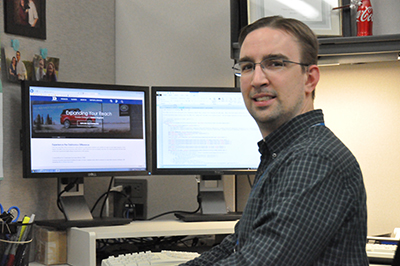
Graphic Communications
My STEM journey began in high school, when I first started to think about what I would do after graduation. During my junior year, I learned about a summer program that introduced computing fields to high school students who were deaf or hard-of-hearing, and offered college credit for participation in summer classes. I signed up and traveled to Washington State to participate.
I already had an interest in computer technology and through this experience I was able to work with computers and meet deaf professionals in computing fields.
After I graduated from high school, I spent one more summer in the AccessComputing Summer Academy for Advancing Deaf and Hard of Hearing in Computing program. I was accepted to study at Moorhead State University of Minnesota (MSUM). Prior to attending MSUM, I had a strong interest in web development and graphic design, which led to me starting some freelance work for a few clients in my hometown.
At that time, computer technology and the Internet were exploding. Because of this, I decided to pursue a bachelor of science degree in graphic communications with an emphasis in multimedia at MSUM.
Due to my profound hearing loss, MSUM provided Real Time Captioning (RTC) in the classrooms. RTC is a transcription service, done by a court stenographer
who transcribes spoken words into text in which then appears on a computer screen. The concept is similar to closed captions we see on videos or on television. RTC allowed me to fully participate in classes. I graduated from MSUM with honors (magna cum laude).
After college, I started working at Daktronics, Inc. in a web and graphics marketing role for corporate websites. Over the years, my role has evolved into a web administrator role, in which I manage the corporate website. Participation in large meetings can be difficult for me, especially when people call-in to participate by teleconference. However, using RTC in these types of meetings solves the access problem.
My STEM journey has required the use of assistive technology. Without cutting edge tools, life in school and work would be much more challenging for those of us with disabilities. The new technology being developed today will continue to help ensure equal access for everyone.
Michael
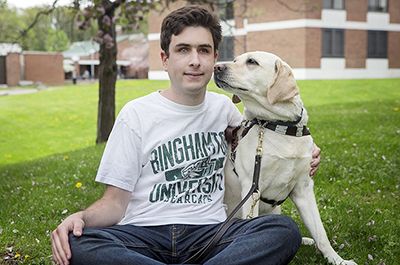
Software Development
My journey as a computer scientist began around the time I entered high school. I had been interested in computers from a young age, but it was around this time that I began to learn to program a computer.
When I started college, I chose computer science (CS) as a major. I think I was the first blind CS major at Binghamton University, and I quickly came to realize that each semester would bring new challenges for making courses accessible. I am totally blind and also hearing impaired; I wear two cochlear implants. Luckily, the Services for Students with Disabilities office assisted in overcoming these challenges; for example, they purchased an embosser capable of printing braille and raised line diagrams. These diagrams allowed me to access the visual aspects of my courses, such as graphs in math courses and circuit diagrams in computer hardware courses.
Soon after I started my first semester, several friends and I launched RS Games, an online gaming network that allows blind players to engage in a variety of board and card games against players from all over the world. The games quickly became wildly popular in the blind community. It was, and still is, an amazing feeling when the code I write has a positive impact on people’s lives. Working on RS Games solidified my interest in computer science.
My journey continued with an internship at Amazon on the textbook rentals team. That summer, Amazon launched textbook rentals, and I helped make the launch possible by developing the system that dispatched reminder emails to customers. It was awesome to be a part of the launch of a new project that would be used by college students all over the country. I enjoyed the challenges of working at Amazon, so when I was offered a full time position at the end of my internship, I accepted.
After I graduated from Binghamton, I moved to Seattle to begin work at Amazon as a software development engineer. At work, I use the NVDA screen reader, which reads the text on the screen out loud and allows me to navigate using the keyboard. I travel independently with the help of my guide dog, a yellow Labrador named Delta.
I do not know where my career as a software developer will lead me. I intend to take things one day at a time, learning as much as I can and improving my skills. I am excited for how my career will allow me to be a part of bringing about improvements that will have a positive impact on the lives of many people for years to come.
Daniel
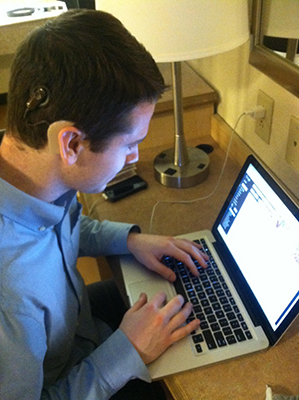
Accessible Technology
“Is it working?” It sounded as though Minnie Mouse was talking, but I could see clearly that the person across from me was my mother, not an over-sized rodent in polka dots. The phrase was not as dramatic as Alexander Graham Bell’s, “Mr. Watson—come in here,” but for me, it was just as momentous. I was thirteen. As my cochlear implant was activated, those three words were the first I had ever heard clearly. I had just entered high school and this was the crossroads in my journey towards independence in the world and a critical impetus toward pursuing a career in a STEM field.
My cochlear implant coupled with sound field technology were key components in my achievements in mainstream schools. This was particularly important because my academic interests naturally gravitated to science and math. My local high school was known for its strengths in those disciplines and offered AP classes both in calculus and computer science that I was able to take advantage of. For me personally, my implant demonstrated the power of technology to create access to sound, accessibility to educational opportunities, and the prospect of a fulfilling career. During high school, I took the most challenging classes available, participating in math and computer science honor societies, and looked forward to a career in technology.
Attending college at the Rochester Institute of Technology (RIT) served to further define my interests in web and mobile app development. The summer after my freshman year, I attended the AccessComputing Summer Academy for the Deaf and Hard of Hearing at the University of Washington and took a course in programming for web development. The experience led me to choose a major in information technology with a concentration in web and mobile app development. My work in my major ultimately prepared me for a summer internship at Bank of America/ Merrill Lynch.
During my senior year at RIT, I worked at a start-up, MotionSavvy, which seeks to use 3D motion sensing technology to develop applications to translate sign language into text. This offered exciting possibilities for improving accessibility for deaf and hard of hearing along with the chance to learn about business from the ground up.
I was excited to return to Bank of America as a technical analyst in the Global Markets group following graduation. I hope to continue to pursue my interests in developing technologies that promote accessibility.
Angela
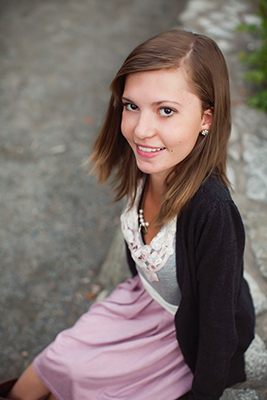
Medicine
I attend Gonzaga University. I’m studying psychology on the pre-med track in order to prepare myself for medical school. Between taking classes and having fun with my friends, I hold a student assistant job in one of the offices on campus.
I am an officer for the Gonzaga Environmental Organization where I am able to share my passions for protecting our planet and promoting sustainability. I also volunteer at Seattle Children’s Hospital. In addition, I have volunteered with Campus Kitchens at Gonzaga providing meals to those in need.
I was born with Muscular Dystrophy (MD), a disease that causes significant weakness in all my muscles. The specific type of MD I have limits my ability to walk quickly and for long distances and to climb stairs. No doubt, living with MD has been a challenge. However, this disease has made me more aware of my abilities, which in turn makes me determined and capable of utilizing my college education to improve the lives of people and inspire others to push themselves, just as I have pushed myself.
My journey in STEM includes summer internships through the Center for Neurotechnology (CNT) at the University of Washington. These were amazing experiences. I was able to work on experiments and gain valuable research experience. I studied the effects of cannabinoid receptor antagonists and agonists on slices of a mouse cerebral cortex to analyze activity in the brain. These experiences taught me that I still have so much to learn in my undergraduate career. My experience with the CNT has solidified my goals for the future in the field of medicine and possibly research as well. I hope to continue my work in the same lab and look forward to engaging in more complex research.
My post-college professional goals may change with time; however, my current plans are to enter the medical field and specialize in pediatrics or psychiatry. I hope to help people with conditions similar to mine.
Hamid
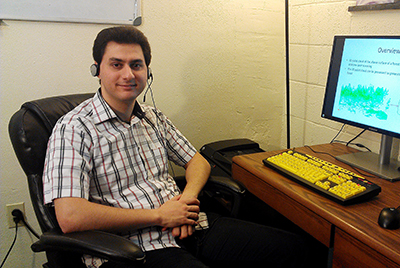
Computer Science
Internships have had a huge impact on my journey in STEM. People may not know what possibilities they have until they get the opportunity, or someone may get stuck in a dead-end job if they can’t try it out first in an internship. It was especially important for me as a person with a visual impairment to discover where I should focus my career.
In summer 2014, I completed an internship at the University of Kentucky. As a third year computer science Ph.D. student, I took this opportunity to see if this would be the lab where I would finish my Ph.D. research. The project I was working on was in collaboration with the Department of Forestry. The problem I looked at was how to model a forest using airborne LiDAR (Light Detection and Ranging) 3D point cloud, which has several millions of points to be processed.
After being involved in the project, I realized that my visual impairment is not a barrier at all, but a hidden power for such a project! Working with 3D images is something that needs a strong mental imaging capacity, rather than a good visual acuity that can only capture one angle to the 3D image at a time. People with vision problems naturally develop stronger mental capacities in order to compensate for their sensing inefficacy,
and here is where I can claim I can potentially be more successful than to a sighted peer. I received a very promising initial result, so now I’m developing this work into my Ph.D. dissertation.
The project has helped shape my future path clearer as I am now certain that I would want to get into a research-based career in STEM, such as a tenure-track professorship or a research position in related industries. It also helped me understand my weaknesses and identify skills I’d like to learn so that I can shape my coursework during the rest of my degree program.
People with disabilities often fear that their disability will limit what they’ll be able to do after school. An internship can be an opportunity to assess a situation in practice, seek accommodations, and alleviate the fear. I can say from my personal experience that persevering to reach a goal can help to overcome fears and improve self-confidence—necessary traits regardless of your aspirations.